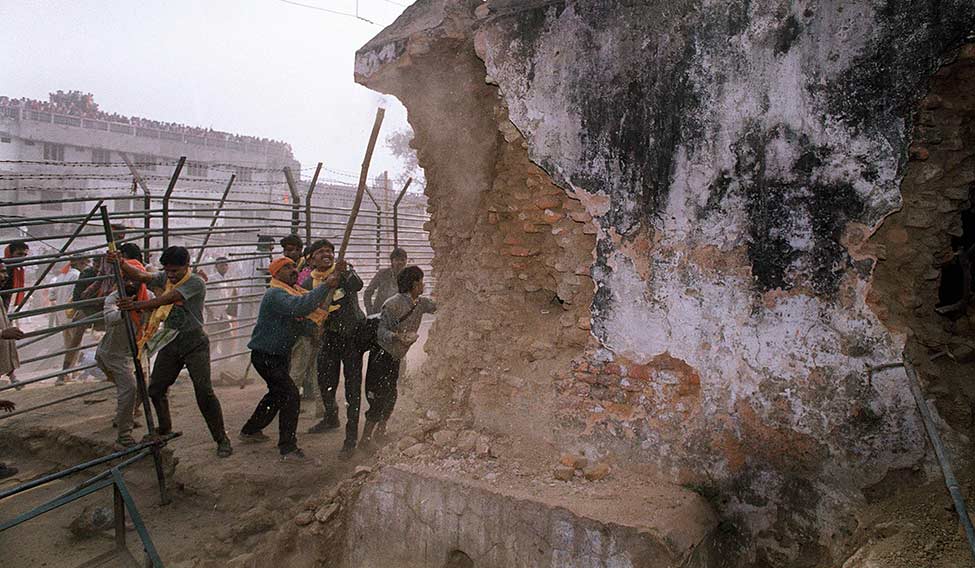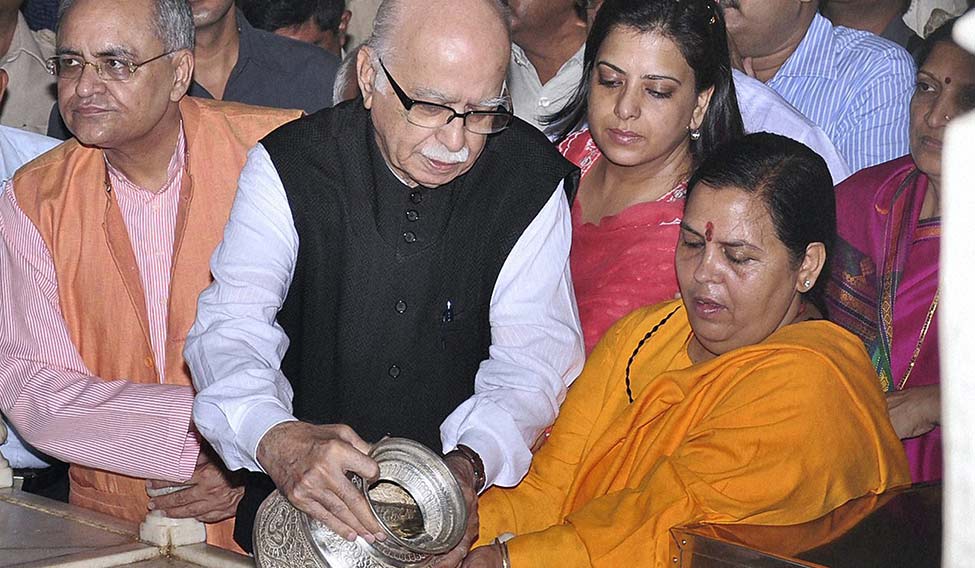None of us who had watched the pulling down of the Babri Masjid on December 6, 1992 never had any doubts about the complicity of L.K. Advani, Murli Manohar Joshi or Uma Bharti in the crime. From atop the Manas Bhavan overlooking the mosque and the disputed plot, we had seen them exhorting and encouraging the kar sevaks.
Now, a quarter century after the crime, the Supreme Court has said that they, too, should face trial. But would it serve any purpose?
I remember the day as yesterday. As I wrote in THE WEEK then, “The view from the terrace of Manas Bhavan on the cool Sunday morning was clear. The mist over the Sarayu had melted away. The 464-year-old shrine stood there in all its decrepit magnificence.”
The Supreme Court had then ordered that there be no construction [of a temple] on the disputed plot. The court’s observer Tej Shankar was told to check whether any construction material was being piled on the disputed plot. Every day, the observer faxed his report to the court: no, no construction material. The Vishwa Hindu Parishad leaders were also telling us: there will be only a symbolic kar seva.
Thus the debate was whether there would be any attempt at construction, in defiance of the court, on the disputed plot. No one was looking at whether anyone was planning a destruction. We had spotted a few men with crowbars the previous day, but tunnel-visioned as we were towards ‘construction’, we missed the plot, literally.
On that Sunday morning, the crowds had assembled fairly early to watch a religious kar seva. By 10am, Sadhvi Ritambara, VHP general secretary Ashok Singhal and Bajrang Dal boss Vinay Katyar arrived. Then came the Faizabad district magistrate and police superintendent, who left the scene as quickly as they had come. By 11, Advani and Joshi arrived in a motorcade, followed by a frenzied mob. “As we saw later, it was this mob that attacked the mosque from the left, seconds after the storming party (whose rehearsal we had seen) captured the left dome,” we wrote then in THE WEEK.
The demolition took nearly four hours. All along we could hear Ritambara and Uma Bharti exhorting the mob on loudspeakers, “aur ek dhakka do, Babri Masjid thod do (one more push, break the Babri Masjid). Advani and Joshi stood there, watching as the mosque was being pulled down “neither appealing to the mobs to leave the mosque nor telling the other leaders to stop egging them.”
Only when a message came that Central forces were on their way (they were not) did Advani pick up the mike and exhort the mob: “Come down from the domes. Otherwise there would be firing at the men on the top of the domes.”
Years later, in his bid for prime ministership, Advani had no qualms about stating exactly the opposite, that he had wept while the mosque was being pulled down.
The demolition act was over in a matter of hours, but the fallout has lingered for a quarter century with cases meandering meaninglessly through the labyrinth of judicial and bureaucratic procedures.
Two first information reports were lodged. One was case number 197 of 1992 against lakhs of kar sevaks alleging the offences of dacoity, robbery, causing of hurt, injuring/defiling places of worship and promoting enmity. The second, case number 198 of 1992, was against Advani, Singhal (now dead), Katyar, Uma Bharti, Ritambara, Joshi, Giriraj Kishore (now dead) and Vishnu Hari Dalmia for offences under sections 153-A, 153-B and 505 of the Indian Penal Code. To confound the confusion, another 46 FIRs were lodged.
A special court in Lalitpur was to try the cases. Later, it was decided that most cases would be tried In a sessions court in Lucknow, while case 198 pertaining to the VIPs would be heard in a Rae Bareilly court.
In October 1993, the CBI filed a chargesheet against 48 persons including Advani, Joshi, Shiv Sena chief Bal Thackeray, UP’s BJP chief minister Kalyan Singh, Mahant Avaidyanath and Mahant Nritya Gopal Das. Four are now dead. Later in the month, the UP government amended the notification and allowed all 49 cases to be tried by the special court in Lucknow. Three years later, in September 1997, the CBI filed a supplementary chargesheet against eight persons. The special court judge soon passed an order that there was a prima facie case of conspiracy against all the accused.
In 1998, A.B. Vajpayee became prime minister, and Advani deputy prime minister. In 2001, eight years after the state government amended the notification, the Allahabad High Court decided that the amended notification was invalid, since the High Court had not been consulted, and so the special court in Lucknow had no jurisdiction to proceed on case 198.
 Fists of fury: Kar sevaks attacking the Babri Masjid on December 6, 1992 | AFP
Fists of fury: Kar sevaks attacking the Babri Masjid on December 6, 1992 | AFP
It took another four months (June 2001) for the CBI to request the UP chief secretary to rectify the defect in the 1993 notification. And 15 months later, on September 2002, the state government rejected the request. This rejection was not challenged by the CBI. Instead, it filed a supplementary chargesheet against the eight accused in a Rae Bareilly court.
ON MAY 4, 2001, the court had dropped proceedings against 21 persons including Advani, Katyar, Uma Bharti, Ritambara, Joshi and Kalyan Singh, taking the view that there were two sets of accused, the kar sevaks who actually demolished the mosque, and others who instigated them. The reason: “The court thought that it was faced with two alternatives, and chose the lesser alternative of dropping the proceedings against these 21 persons so that the proceedings against the kar sevaks could carry on.”
This order was challenged in the High Court. On May 22, 2010, the High Court upheld the special court judgment. It agreed with the special court that criminal conspiracy was never made out against the eight accused. It was against this order of May 2010 that the CBI approached the Supreme Court.
Now, another seven years later, a division bench of Justices Pinaki Chandra Ghose and Rohinton Nariman has spoken, in effect asking Advani, Joshi, Bharti and others to face prosecution.
The rationale of the court is impeccable. The CBI had filed a joint chargesheet because all the offences were committed in the course of the same transaction. “The evidence for all these offences is almost the same and these offences, therefore, cannot be separated from each other, irrespective of the fact that 49 different FIRs were lodged.”
The court has blamed the CBI for the delay. “...[T]he High Court expected that the defect noticed in the notification would be cured soon after the delivery of the judgment... This, however, did not happen... Instead, the course taken by the CBI has caused great confusion. The filing of the supplementary chargesheet against eight accused persons which is going on separately at Rae Bareilly and the dropping altogether of charges against the 13 accused persons, after the judgment dated 12th February, 2001 has completely derailed the joint trial envisaged and has resulted in a fractured prosecution going on in two places simultaneously based on a joint charge sheet filed by the CBI itself.”
So the court has now found a remedy. “... [T]he best course in the present case would be to transfer the proceedings going on at Rae Bareilly to the court of sessions at Lucknow so that a joint trial of all the offences mentioned in the joint charge sheet filed by the CBI against the persons named could proceed.”
In other words, 25 years after the crime was committed, it is back to square one. And now how much longer? The court has directed that the proceedings be fast-tracked. Additional charges will be framed within four weeks. The proceedings will be on a day-to-day basis. The trial judge won’t be transferred till he completes the work. The case shall not be adjourned on any ground except when the court finds it impossible to carry on on that particular date (then the next earliest date). The CBI shall ensure that on every date fixed for evidence, some prosecution witnesses will be present. “The sessions court will complete the trial and deliver the judgment within... two years from the date of receipt of this judgment.”
So in two years, there will be a decision by the trial court. There will be appeal over that to the High Court and maybe further to the Supreme Court. How long will all these take is anyone’s guess.
And how many of the accused will be alive to see the so-called “ends of justice” being met?














